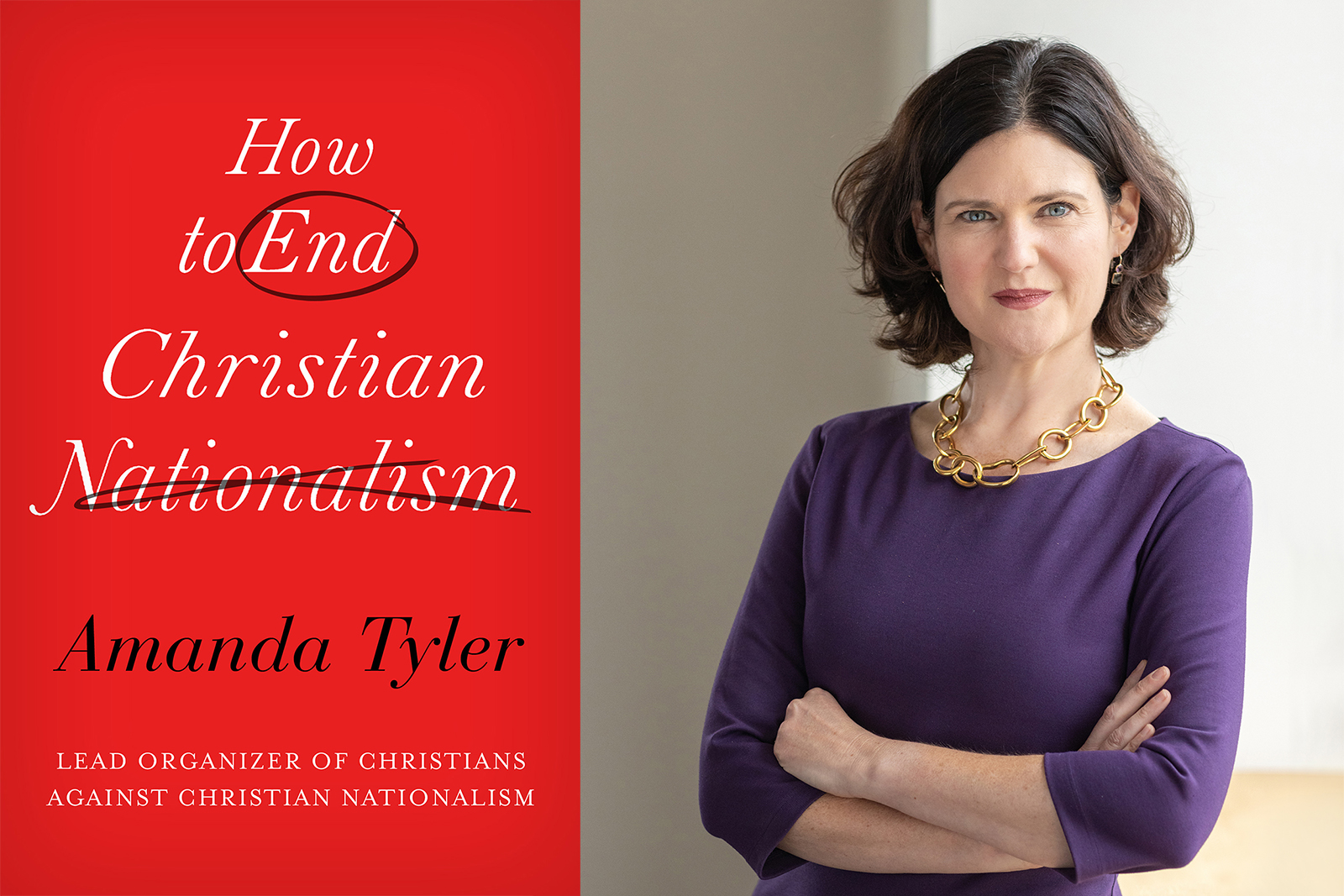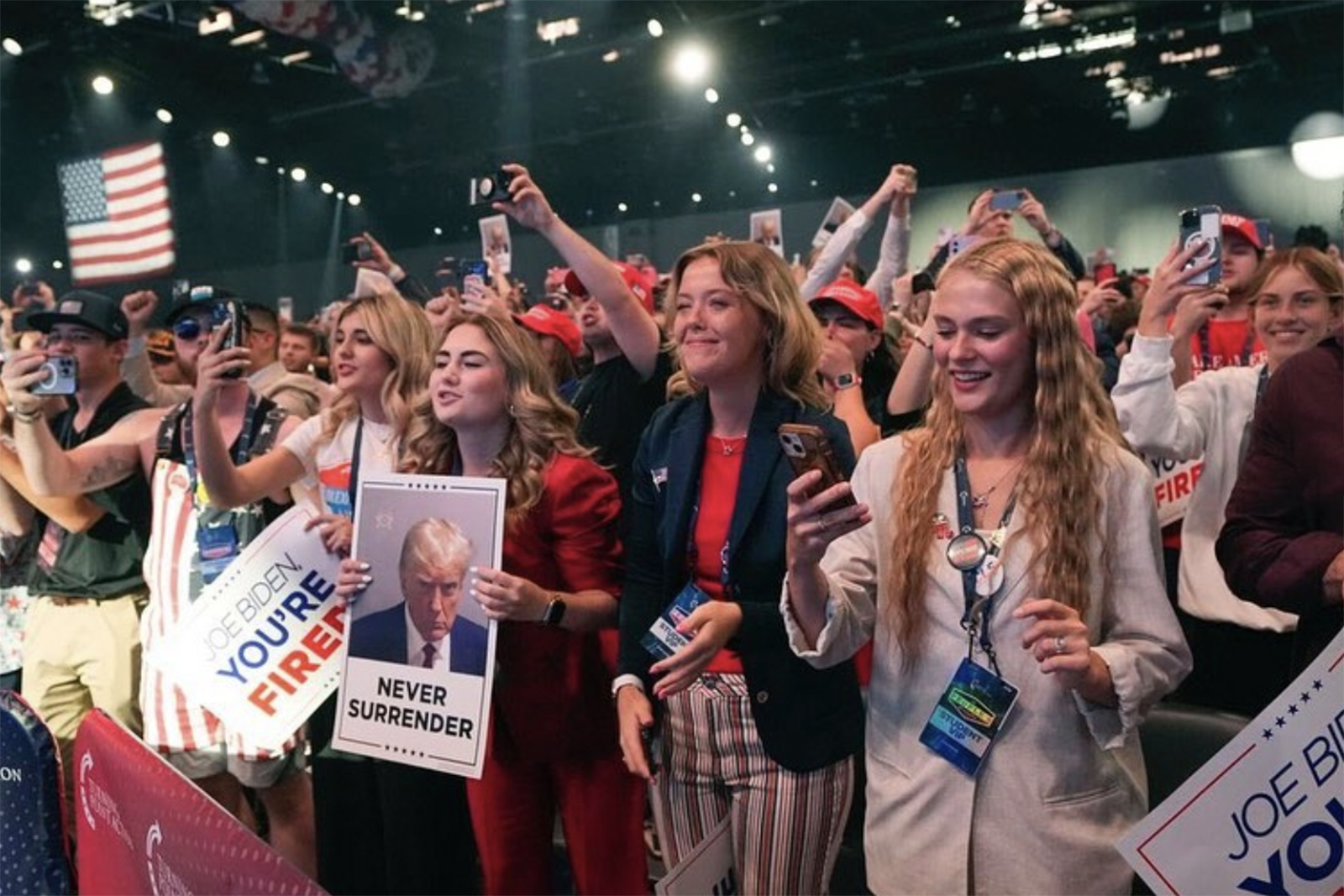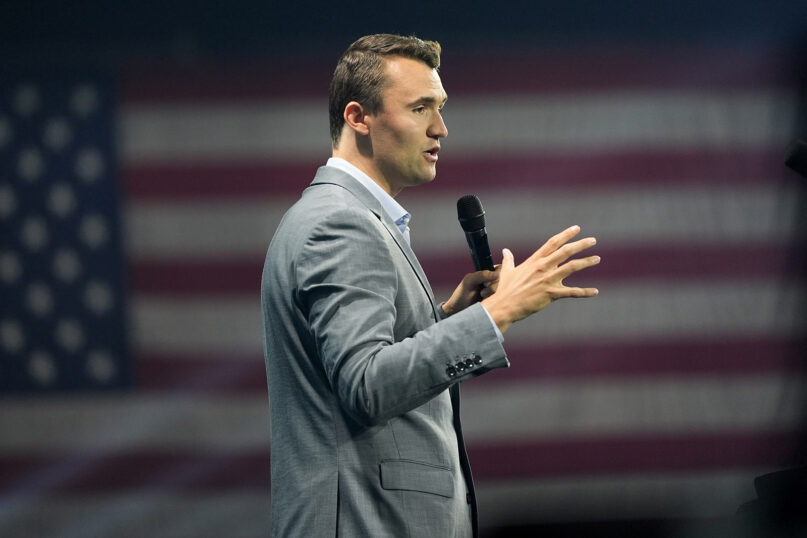With Bible verses and Baptist zeal, Amanda Tyler offers how-to for dismantling Christian nationalism
(RNS) — In her debut book, 'How to End Christian Nationalism,' Tyler presents a roadmap to building multiracial interfaith coalitions and fostering what she calls 'uncomfortable' but necessary conversations — especially for white Christians.

"How to End Christian Nationalism" and author Amanda Tyler. (Courtesy images)
Fiona Murphy
November 1, 2024
(RNS) — On a Saturday morning in 2009, Amanda Tyler was in a grocery store parking lot in Austin, Texas, setting up for Democratic Congressman Lloyd Doggett’s “neighborhood office hours,” when a large crowd of conservative protesters swarmed the congressman and his staff, waving “Don’t Tread on Me” flags and holding signs with Rep. Doggett’s face, drawn with devil horns, printed on tombstones and written with messages like “No Socialized Healthcare.”
Tyler, who was Doggett’s district director at the time, recalls this moment as the most intimidating of her career. The same protesters, she said, stalked the congressman for months afterward, attending different events, brandishing assault rifles and shouting about evil.
“It gave me a very close-up experience with the political tactics that could be used and how violent they could be,” Tyler said. “They had distorted the congressman’s face to look like a demon — so dehumanizing — and used symbols that felt like spiritual warfare.”
The event in Texas was a turning point for Tyler, who would a decade later launch the initiative “Christians Against Christian Nationalism” in 2019, and in 2021, become the executive director of the Baptist Joint Committee for Religious Liberty, where she advocates for religious liberty and the separation of church and state.
The chaos and hostility of that Saturday morning in Texas, Tyler says, served as a prelude to the political intimidation tactics seen on Jan. 6, 2021.
“Christian nationalism was not the sole cause of explanation for the events of January 6, but it played a vital role in the events leading up to the siege and provided a unifying ideology for many disparate groups that day,” Tyler writes in her debut book.
“How to End Christian Nationalism,” published Oct. 22, presents itself as a roadmap to building multiracial interfaith coalitions and fostering what Tyler calls “uncomfortable” but necessary conversations — especially for white Christians. The task of dismantling Christian nationalism, Tyler warns, is generational work.
“It is up to us to confront and call out the destructive ideology that it is and … the damage that it is causing our country.”
In her view, Christian nationalism is not just a theological distortion but a dangerous ideology with real-world consequences. It’s a movement, she argues, that undermines the core principles of both Christianity and democracy. According to Tyler, the ideology promotes the idea that America was founded as a Christian nation, and to be an authentic American, one must subscribe to a conservative, often Protestant, expression of Christianity. She argues that Christian nationalism distorts the gospel of Jesus, which represents to her a message of lovingkindness “beyond recognition.
“Jesus eschewed political power in favor of a ministry aligned with those who were oppressed, marginalized, and otherwise harmed by that power,” Tyler writes. “It (Christian nationalism) points not to Jesus of Nazareth but to the nation, as conceived by a dangerous political ideology, as the object of allegiance.”
Her experiences as a lawyer and activist in Texas and Washington, D.C., buttress an argument that links Christian nationalism to the violent events of Jan. 6, white supremacy and xenophobia. Her religious background, a Baptist from Austin, lends an urgency to the stakes at play.
“It is not a memoir, but there is a lot of my personal story in it,” Tyler told RNS.
As Tyler describes it, her journey to end Christian nationalism began 40 years ago when she “made my profession of faith in the baptismal waters at Riverbend Baptist Church in Austin, Texas,” she writes.
“This is just who I am,” Tyler said. “Learning about Jesus, trying to become a better Christian … This work trying to end Christian nationalism now as a lifelong calling. I didn’t know that at the time, I was only 7, but that started me on this path.”
While her faith was developing, so were her political aspirations. At 6, Tyler recalls studying local city council candidates and pestering her politically inactive parents about who they would vote for. “I was a bit of an outlier, even in my own family,” she said. After hearing a Texas state senator speak at career day, she knew she was destined to become a lawyer.
“I raised my hand and asked him, how does one become a senator?” Tyler said. “He suggested that I go to law school.”
Tyler’s book takes a systematic approach, organized into eight sections titled “Step One” through “Step Eight.” Many end with a reading and reflection exercise that incorporates biblical Scripture. “I pray that it is a hopeful resource for people in growing the movement against Christian nationalism,” Tyler said.
In “Step One,” she introduces a sociological survey designed to help readers orient themselves to Christian nationalism. Some of the questions read, “The federal government should advocate Christian values” and “The success of the United States is part of God’s plan.”
“I hope people see that this is not something that impacts a select part of the population,” Tyler said. “It’s something we all have a stake in.”
Christian nationalism is an ideology that exerts its influence along a spectrum, according to Tyler. She notes instances in American history: from the Naturalization Act of 1790, which was the first law in the United States outlining rules for granting citizenship, to the rapid growth of the Ku Klux Klan to the Red Scare of the 1950s when “In God We Trust” became a national motto.
In essence, Tyler argues that Christian nationalism relates to white supremacy in its promotion of exclusionary visions of power — one through race, the other through religion — and how they often overlap in rhetoric, goals and supporters.
“Since Christian nationalism perpetuates both white supremacy and Christian supremacy,” Tyler writes, “white Christians are still at the top of the caste system created in part by Christian nationalism.”
Tyler’s advocacy is rooted in personal experience and spiritual conviction — but she is not interested in doing this work alone. In January of 2023, she launched the podcast “Respecting Religion” with co-host Holly Hollman. They often discuss the intersection of faith, politics and social justice with guests like Jemar Tisby, the Rev. Jay Augustine and the Rev. Joseph Evans. Tyler emphasizes the need to center people of color in the work of dismantling Christian nationalism.
“There’s a tendency sometimes for white people to think that we have to run and invent everything,” Tyler said. “But there are already groups who are doing this work — whether or not they’ve called it Christian nationalism.”
Frequently addressing her readers using “we,” Tyler suggests that her readers are likely white, Christian and concerned. She avoids labeling individuals as Christian nationalists. Like a few studies she cites, Tyler says she wants to focus on the dynamics of the ideology rather than assigning the label to a group of people.
It isn’t difficult, however, for readers to imagine the contemporary Christian nationalist Tyler neglects to describe: Images of those who stormed the capitol on Jan. 6 were rife with Christian flags and Bible verses. However, in her book, Tyler is clear the messaging has reached far more than the most extreme ends of the spectrum. She warns that many of “our friends, relatives and colleagues” may be “falling prey” to Christian nationalist messaging.
“They need people in their lives — people like you and me,” Tyler writes, “who can help them understand Christian nationalism well enough to reject it.”
This article was produced as part of the RNS/Interfaith America Religion Journalism Fellowship.
(RNS) — Since 2020, TPUSA chapters have appeared at over 45 Christian colleges or universities, though only 21 of those chapters appear currently active.

People attend Turning Point USA's Young Women’s Leadership Summit in San Antonio, Texas, in June 2024. (Courtesy photo)
Kathryn Post
November 1, 2024
(RNS) — Just eight days shy of Election Day, 31-year-old political activist Charlie Kirk addressed a sea of college students in glaring-red MAGA hats at Grand Canyon University, near downtown Phoenix.
Sporting a black T-shirt emblazoned with “xy = man” — a confirmation of where he stands on the GOP’s 2024 litmus test issue — Kirk, who founded Turning Point USA as a college student in 2012, was interrupted as his audience erupted into a rendition of “The Star Spangled Banner.” Afterward, students grabbed up TPUSA swag that said “Republicans are hotter” and “dump your socialist boyfriend.”
“Gen Z is waking up … and voting,” Kirk posted on X later that day. “WATCH.”
Kirk’s fall 2024 “You’re Being Brainwashed” tour is an effort advertised as a way to help students “challenge left-wing indoctrination on college campuses.” TPUSA has already signed up nearly 800 college chapters, but the event at GCU, established by Baptists but now calling itself interdenominational, is part of Kirk’s recent push to populate evangelical Christian campuses with TPUSA chapters.
Since 2020, TPUSA chapters have appeared at more than 45 Christian colleges or universities, at least 35 of them affiliated with the Council for Christian Colleges and Universities, the largest association of Christian schools. Only 21 chapters at Christian universities appear currently active, however, with even fewer officially recognized by the universities themselves.
Expanding to Christian colleges, some scholars warn, may divide their campuses. The group, whose website says it plays “offense with a sense of urgency to win America’s culture war,” gained notoriety in 2016 for its professor watchlist, which prompted harassment of faculty at secular as well as Christian colleges, who, TPUSA said, “advance leftist propaganda.”
Kirk has disputed the results of the 2020 election, questioned the qualifications of Black pilots, called George Floyd a “scumbag” and said a Bible verse about stoning gay people to death is “God’s perfect law.”
“The Democrat Party supports everything that God hates,” Kirk said at a recent campaign event he organized for Donald Trump. TPUSA did not respond to requests for comment.
Students at Christian colleges who have launched or joined TPUSA chapters said in interviews this fall that the group helps build community and gives them a place to discuss conservative values
“They say that we are racist and homophobic,” said Payton Stutzman, president of the TPUSA chapter at Liberty University in Lynchburg, Virginia, without specifying who “they” referred to. “We’re really not. We really just want to get together and have a good time. The main things we support is a secure border, a good economy, and the freedom to raise our family the way we think is right. We are not here to push anybody’s beliefs down their throats.”

Gary Bruce and Brittany Kemper dance before Republican presidential nominee former President Donald Trump speaks at a Turning Point Action campaign rally, Wednesday, Oct. 23, 2024, in Duluth, Ga. (AP Photo/Alex Brandon)
Sarah Stock, a junior political science major at Vanguard University, a Christian university in Orange County, California, started a TPUSA chapter last fall as an outlet, she said, for political dialogue in what she described as an otherwise apolitical campus.
Last year at a screening of Matt Walsh’s “What Is a Woman,” a film in which Walsh, a controversial podcast host, talks about transgender issues, approximately 100 students attended. Among them was a group of friends who came up to debate the TPUSA members during a Q&A session.
“We all were like, I respect you have this opinion, and it’s great that we can talk about it,” said Stock, who said that after momentarily growing tense, the two groups ended up laughing together. “It was just this mutual understanding that you can love other people and still disagree with them.”
Generally operating in more conservative environments, TPUSA chapters on Christian campuses face less opposition than peers at secular universities but aren’t exempt from controversy. In 2023, Whitworth University put their TPUSA chapter on probation after a free speech event encouraged students to write whatever they wanted on a beach ball, vulgarities included. A year earlier, a now-defunct TPUSA chapter at Calvin University in Grand Rapids drew backlash after advertising a Kanye West-themed event in the wake of West’s antisemitic comments
“The tone of TPUSA social media, and the tone of Charlie Kirk’s rhetoric, to me, it seems there’s a conflict there between kind of that brand, and the more thoughtful political discourse that Christian colleges historically have been working to cultivate,” said Kristin Kobes Du Mez, professor of history and gender studies at Calvin University.
Since TPUSA launched its Faith Initiative in 2021, which partners with churches to host religious conferences, Kirk’s rhetoric about “reclaiming the country for Christ” has grown more bold, earning Kirk the label of Christian nationalist.
“If the church does not rise up at this moment, if the church does not take its proper role, then the country and the republic will be gone as we know it,” Kirk said at a May 2021 TPUSA Faith event at Dream City Church in Phoenix.

Turning Point USA Founder Charlie Kirk speaks before Republican presidential candidate former President Donald Trump arrives at the Turning Point Believers’ Summit, Friday, July 26, 2024, in West Palm Beach, Fla. (AP Photo/Alex Brandon)
Kyle Spencer, whose 2024 book “Raising Them Right” chronicles America’s conservative youth movement, is unequivocal in describing Kirk as a Christian nationalist, but political commentator Isaac Willour, a graduate of the Christian Grove City College, called it an “obvious jump” to conflate “those who have a pop interest in TPUSA talking points” with “the actual radical right.” TPUSA, he noted, has distanced itself from radical conservatives such as Nick Fuentes and Morgan Ariel.
“There’s a very easy trap to fall into … that advocating for Christians who meaningfully use any kind of political process, anything that’s not really quietism, is Christian nationalism,” said Willour.
Stock said, “It seems like there’s a high demand for Christian nationalism in the media, but I think there’s a pretty low supply of it.”
Before TPUSA Faith, there was the Falkirk Center for Faith and Liberty, a think tank located at the evangelical powerhouse Liberty University in Virginia. The brainchild of Kirk and then-Liberty President Jerry Falwell Jr., the center, founded in 2019, brought Trump allies such as Eric Metaxas and Rudy Giuliani to campus but ultimately lost steam as Falwell encountered scandal and eventually resigned.
Kirk’s legacy lives on in the school’s TPUSA chapter, which ballooned from 175 members over the summer to over 600, according to Stutzman, crediting the election. (He also touts its pickleball, trivia and Shrek-themed “drain the swamp” movie nights.) Voter registration has been a top priority.
“Right now, Virginia is in a spot where it could flip,” said Stutzman, who was doorknocking for the Trump campaign as he spoke to RNS. “While we can’t endorse anybody, we can support our values, and we can work with college Republicans and other clubs that can endorse people, and we can provide them resources.”
Many TPUSA Christian college chapters have hosted debate watch parties and have plans for election night gatherings. At Liberty, local and federal politicians are expected to attend the chapter’s formal election night gala.
JJ Glaneman, a sophomore at Duquesne University, a Catholic university in Pittsburgh, told RNS he’d also recently been doorknocking for Trump and GOP Senate candidate David McCormick.
Duquesne’s TPUSA chapter is unofficial. After attending TPUSA’s multi-day AmFest event in Arizona in December 2023, Glaneman filed to start a formal chapter in January but was denied by student government, who, Glaneman said, cited TPUSA’s values. Instead, Glaneman has co-founded a chapter of the 132-year-old College Republicans that they use as a “shield,” he said, to host conservative events on campus.
RELATED: With Turning Point Faith, pastors use politics as a church-growth strategy
According to Matt Boedy, a professor of religious rhetoric at the University of North Georgia, TPUSA’s “star-studded” conferences, big-name speakers and viral political debates make TPUSA a more attractive option than a College Republicans chapter.
There’s also TPUSA’s funding. Tax filings from June 2023 showed that TPUSA took in $81.7 million, up from $2.05 million in 2015. Stock said that while her group could apply for “like $50 a year” from Vanguard, “we just get everything from Turning Point.”

Claire Bettag. (Courtesy photo)
Claire Bettag, a senior at St. Mary’s Notre Dame, said the Indiana Catholic school denied her attempt to found a chapter in 2022 due to TPUSA’s messaging on LGBTQ+ issues. Despite the rejection, Bettag has maintained an unofficial TPUSA chapter and a College Republicans club at the school and said TPUSA encouraged her to speak out when St. Mary’s decided to offer open enrollment to applicants “who consistently live and identify as women,” which included transgender students.
“We had met with the school board, the president, the vice president of the college, and we started multiple protests and did a lot of activism to get this policy reversed,” said Bettag. “I have confidence now to speak out about my conservative values that I never thought that I could ever have, and it’s because Turning Point really backed me up along the entire process.”
Saint Mary’s reversed its decision a month later, by which time, Bettag said, her unofficial TPUSA chapter had grown to 75 members.
Catholic University of America has also been hesitant to welcome TPUSA to its campus, as have some Protestant colleges. In 2021, Point Loma Nazarene University, a Church of the Nazarene school in San Diego, and Taylor University, an evangelical school in Upland, Indiana, said the national group conflicts with their mission statements.
The Grand Canyon University event shows that TPUSA’s efforts to enroll Christian students aren’t slowing down, and while Spencer said it’s still a question whether the campaign will translate to votes, Stutzman, at Liberty, said not all gains are political.
“Ultimately, at the end of the day, it’s not just political warfare,” he said. “It’s spiritual warfare that we’re fighting as well.”
Opinion
Once a beneficent King Cyrus, Trump has lately been cast as a biblical avenger
(RNS) — Charismatic 'prophets' have long compared Trump to Bible characters to justify their support for the former president. But the latest iteration, as King Jehu, may signal tacit acceptance of political violence.

Republican presidential nominee former President Donald Trump arrives for a campaign rally at Lee's Family Forum, Thursday, Oct. 31, 2024, in Henderson, Nev. (AP Photo/Julia Demaree Nikhinson)
Matthew D. Taylor
November 1, 2024
(RNS) — He’s a type of a Cyrus, the ancient Persian emperor. Or a modern Job, defiantly enduring devilish persecutions. He’s Esther, positioned by providence “for such a time as this.” Now he’s a David, a flawed but anointed man of God …
Meet Donald Trump, biblical paragon.
In the past decade, Trump’s Christian theologizers, whom I write about in my new book, have made a hobby of connecting the famously profane, philandering, greedy real estate mogul to biblical heroes and quotable Bible verses. The medley of Bible characters, all mirrors of Trump and his cosmic destiny to lead America, are a pillar of his appeal to evangelical Christians
More recently, however, these biblical allusions and correlations have taken a menacing turn. The latest iteration of this trope is Trump as the obscure Hebrew Bible character King Jehu, an equivalence that may signal tacit acceptance that Trump is bringing in a tide of violence.
RELATED: Lance Wallnau, first to ‘prophesy’ Trump’s presidency, is back to vanquish anti-Trump demons
Almost as soon as Trump entered the political scene in earnest, charismatic prophets, whose evangelical followers believe they literally speak the word of God today, have cast Trump as a figure of biblical prophecy. The original and perhaps still the most iconic such comparison was put forward by Alabama pastor Jeremiah Johnson just a month after Trump became a presidential candidate in 2015, matching Trump with the Persian King Cyrus the Great.
After Cyrus and his Persian armies conquered the Babylonian Empire, Cyrus sent the Israelites, then captive in Babylon, home to rebuild Jerusalem. The prophet Isaiah refers to Cyrus as God’s “anointed,” noting that the gentile king does not acknowledge the Hebrew deity. In Isaiah’s vision, Cyrus is a secular deliverer, an instrument in the hand of God.
This Cyrus-Trump comparison became one of the key evangelical rationalizations for supporting Trump in 2016: He’s not a believer, or even a good man, but he’s God’s man. Johnson and the handful of other prophets who wagered big on Trump’s win became celebrities in evangelical media. Charismatic prophets such as Lance Wallnau and Paula White then brokered the porcupine-hugging partnership between Trump and his ever-loyal evangelical voter base by casting Trump as the pseudo-biblical, God-selected instrument for restoring American Christianity.
Thus started an avalanche of such prophecies. Incentivized to feed the ravenous demands of his Christian supporters for more and more positive messages about Trump, hundreds — perhaps thousands — of charismatic evangelical prophets have jumped into the pro-Trump prophecy marketplace.
But since Harris became Trump’s opponent, the dominant biblical figure invoked in these prophecy circles has begun to shift away from Cyrus (or Job, Esther or David) and toward Jehu, a chilling model for the post-election season.
Jehu ascended to the throne of Israel after the infamously wicked rule of King Ahab and Queen Jezebel, two of the most loathsome characters in the biblical narrative, who had led the people of Israel into worshipping false gods, persecuted the godly Israelite remnant and squared off against the famed prophets Elijah and Elisha.
Jezebel’s name was once a common byword for a scheming woman, but in charismatic circles, where the Hebrew Bible’s imagery looms larger than life, it still has force as a description of sexual promiscuity, abortion, LGBTQ+ rights and other attributes of what they view as malign feminism. Charismatic prophets have, for decades, lamented how the “spirit of Jezebel” has taken over American culture, and Harris, upon becoming the Democratic nominee, was almost instantly tagged with the name.
Jehu, anointed king after Ahab’s death, presides over Jezebel’s annihilation. He demands her servants cast her out of a high tower, then tramples her body with his horse. Wild dogs come and eat her corpse. The message of the story: Jezebel was so profane, so heinous, that all memory of her was eradicated.

“Queen Jezebel Being Punished by Jehu” by Andrea Celesti, late 17th century. (Image courtesy Wikimedia/Creative Commons)
A few weeks ago, tens of thousands of evangelicals gathered on the National Mall for a day of prayer, worship and prophecy to sway the election. At the culmination of 10 hours of politicized religious fervor, one of the most respected charismatic Christian leaders in the country, a California pastor and apostle named Ché Ahn, who this week was photographed at the center of a circle of Christian leaders laying hands on and praying over Trump, got up to declare the will of God: “Donald Trump is a type of Jehu, and Kamala Harris is a type of Jezebel. As you know, Jehu cast out Jezebel. … I decree in Jesus’ mighty name, and I decree it by faith that Trump will win on November the 5th, he will be our 47th president, and Kamala Harris will be cast out, and she will lose.”
RELATED: Lance Wallnau, first to ‘prophesy’ Trump’s presidency, is back to vanquish anti-Trump demons
Linking the vice president — herself a Baptist Christian — to Jezebel in our political violence-charged moment verges on a threat on her life.
Another provocation came as Trump gathered with his National Faith Advisory Board, his formal circle of evangelical advisers, on Oct. 25, and Messianic Rabbi Jonathan Cahn, author of bestselling books about prophecy, uttered this pronouncement over Trump from the stage:
President Trump… God called you to walk according to the template of Jehu, a warrior king. He called Jehu to make his nation great again. Jehu came to the capital city with an agenda to drain the swamp … If (God) should now bring you to the height of power, it will be for his glory. It will be the last act and maybe America’s last chance of redemption.
Cahn and the other prophets employing this image are not merely noting interesting parallels between Trump and Jehu. Rather, they are directing Trump to operate according to the template of Jehu, a biblical script that must be fulfilled.
Note, for instance, how Jehu “drained the swamp” of Israel, a story related in the Bible’s second Book of Kings. The execution of Jezebel pales in comparison. After Jezebel’s defenestration, Jehu goes on a rampage, slaughtering all of Ahab and Jezebel’s children, piling up their heads at the city gates. He goes on to murder hundreds of Israelite citizens, including religious leaders who backed Jezebel. One of the most brutal and vindictive scenes in the Bible, Jehu’s vengeance is being offered as the divinely ordained template for a second Trump term.
PODCAST: The peril radicalizing some evangelicals goes beyond Christian nationalism
We might dismiss the comparisons to Jehu as metaphor if we had not listened to Trump’s recent rally speeches. These biblical citations echo Trump’s own campaign rhetoric, which itself has taken a more vengeful, violent turn. He launched his 2024 campaign by declaring, “I am your warrior. I am your justice. And for those who have been wronged and betrayed: I am your retribution.” He’s closing it with promises to eradicate “the enemy within” and calling his American opponents “vermin.”
Like Jehu’s rampage against the old regime, Trump promises to purge the government and society (with violence if necessary) of the malign forces his people hate and fear.
These biblical invocations reveal the accommodations Christians have made to embrace a populist authoritarian vulgarian. As the sourcebook for all truth and guidance in evangelical belief, the Bible shapes evangelical Christians’ imaginations. Casting Trump as a Jehu creates theological permission for Christians to embrace Trump’s promised violence.
If he wins in this election, the Jehu image tells Trump’s Christian supporters that some real-world violence may be needed to purge America of her demons. If he loses, particularly to Kamala Harris, the Jehu template prescribes vengeance and violence until the Harris regime is annihilated.
(Matthew D. Taylor is a senior scholar at the Institute for Islamic, Christian and Jewish Studies in Baltimore and is the author of “The Violent Take It by Force: The Christian Movement That Is Threatening Our Democracy.” The views expressed in this commentary do not necessarily reflect those of Religion News Service.)


